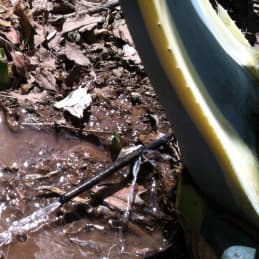AMWUA Blog
BY: Kathleen FerrisKeep That Lovely Yard And Save Water

Valley homeowners use as much as 70 percent of their water outside, particularly during the summer months. Here's the frustrating part: many homeowners can grow the same lovely outdoor spaces with the same gardens, grass and trees and use far less drinking water to do it. The trick is an efficient irrigation system.
The key to an efficient irrigation system is a homeowner or landscaper who is paying attention. Here are a few basic guidelines to increase the efficiency of your irrigation system and save water and money.
The Drip System
- It feels very green to take those bubbler heads off your irrigation system and replace them with drip lines, but drip systems are always a work in progress. The materials are fragile. Underground pipes can crack and leak, tubes leading to plants can be cut by trimming tools or can split from wear. Emitters fall off or get clogged with dirt. Homeowners or their landscapers need to check the system regularly and replace or fix broken parts.
- Many emitters commonly used on drip systems don’t control for pressure. Plants closer to the irrigation valve or at the bottom of a slope get overwatered from heavy flow. Other plants start looking sad because they are getting too little water or the water is running off too quickly to be absorbed. Homeowners typically respond by overwatering the entire yard. Using inexpensive “pressure compensating emitters” found in home improvement and irrigation supply stores help each plant get the same gallon or half-gallon per hour. These emitters also slow the water’s flow rate so it sinks deep into roots.
The Sprinkler System
- If sprinkler heads have a 15-foot spray capacity but are placed 18 feet apart, then a homeowner will have to overwater to avoid yellow patches. To maximize the efficiency of your sprinkler system make sure the heads are spaced correctly and don’t forget to put sprinkler heads in the corners of your yard to keep grass evenly green.
- The most efficient sprinkler nozzle is called a “stream rotor nozzle”. Instead of a single stream of water, these sprinkler nozzles use multiple fingers of water. They cover more evenly and their reach is more flexible. If you inherited a poorly spaced sprinkler system, installing these nozzles could extend a sprinkler’s reach and restore the health of yellow patches without over watering the rest of the turf or rearranging the heads.
The Control Box
- The efficiency of an automated control box depends on the operator. It saves water if the person who sets the timer understands the amount of water plants and trees need in each zone during any given week or month. For example, it’s not unusual for homeowners or landscapers to set the control box to soak winter grass seedlings and leave it there all winter. You’d get the same great lawn, without the mushrooms and with less mowing, by reducing the watering time to accommodate a mature winter lawn.
- In an effort to take the iffy human element out of irrigation, the industry has manufactured control boxes that operate based on weather conditions or soil moisture probes. While these often do a more efficient job than other controllers, they still need a human to program them. For example, some weather-responsive control boxes ask the homeowner a series of questions about types of plants, soil conditions, sun exposure and slope. If the answers are wrong, even a fancy control box can waste water.
You can find a free class about watering your garden in a location near you. Water - Use It Wisely has an online watering guide . Most nurseries can give you a free hard copy of the guide. AMWUA conservation pages are filled with good information about how to irrigate grass and plants.
For 45 years, Arizona Municipal Water Users Association has worked to protect our member cities’ ability to provide assured, safe and sustainable water supplies to their communities. For more water information visit www.amwua.org.
